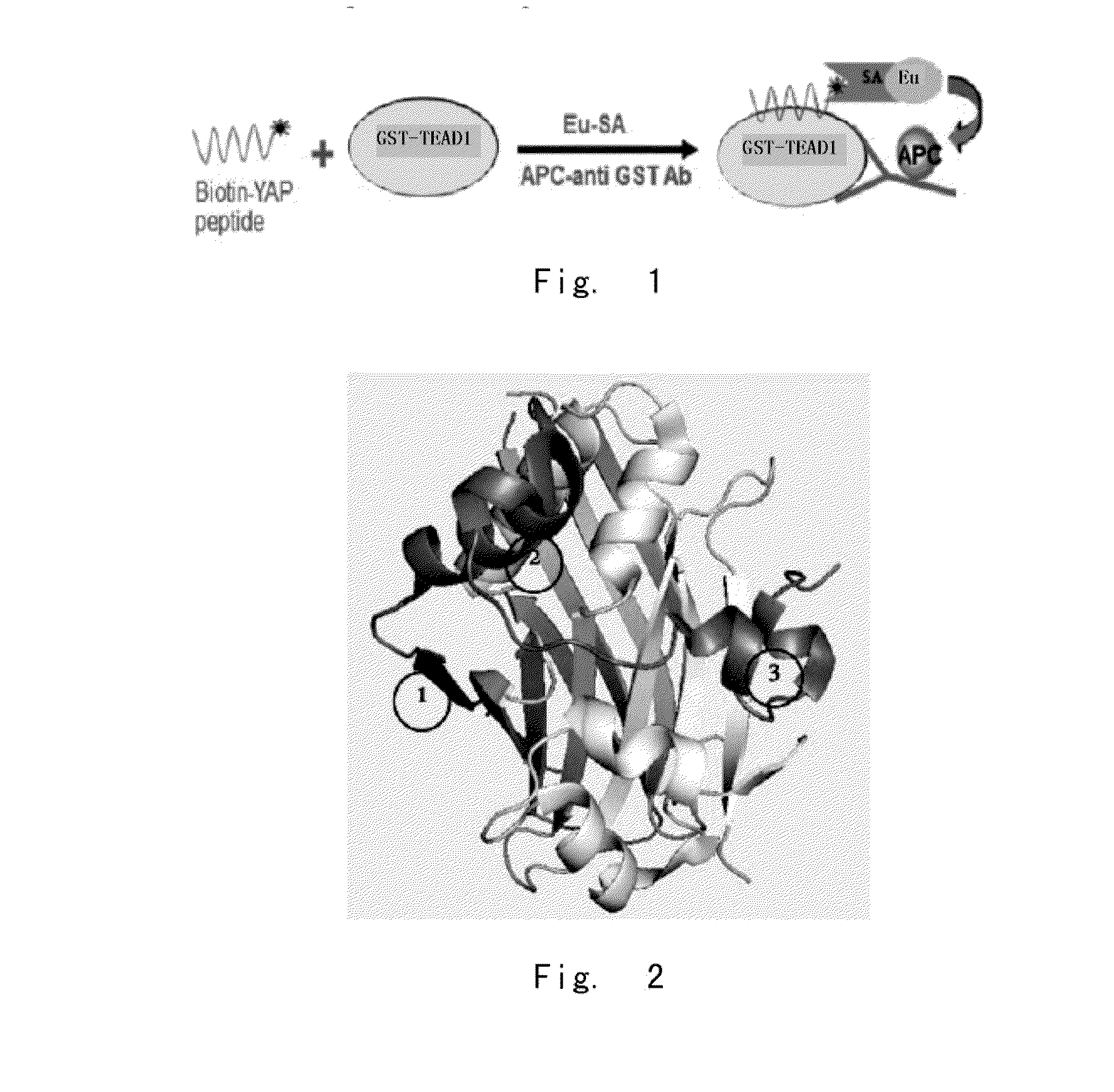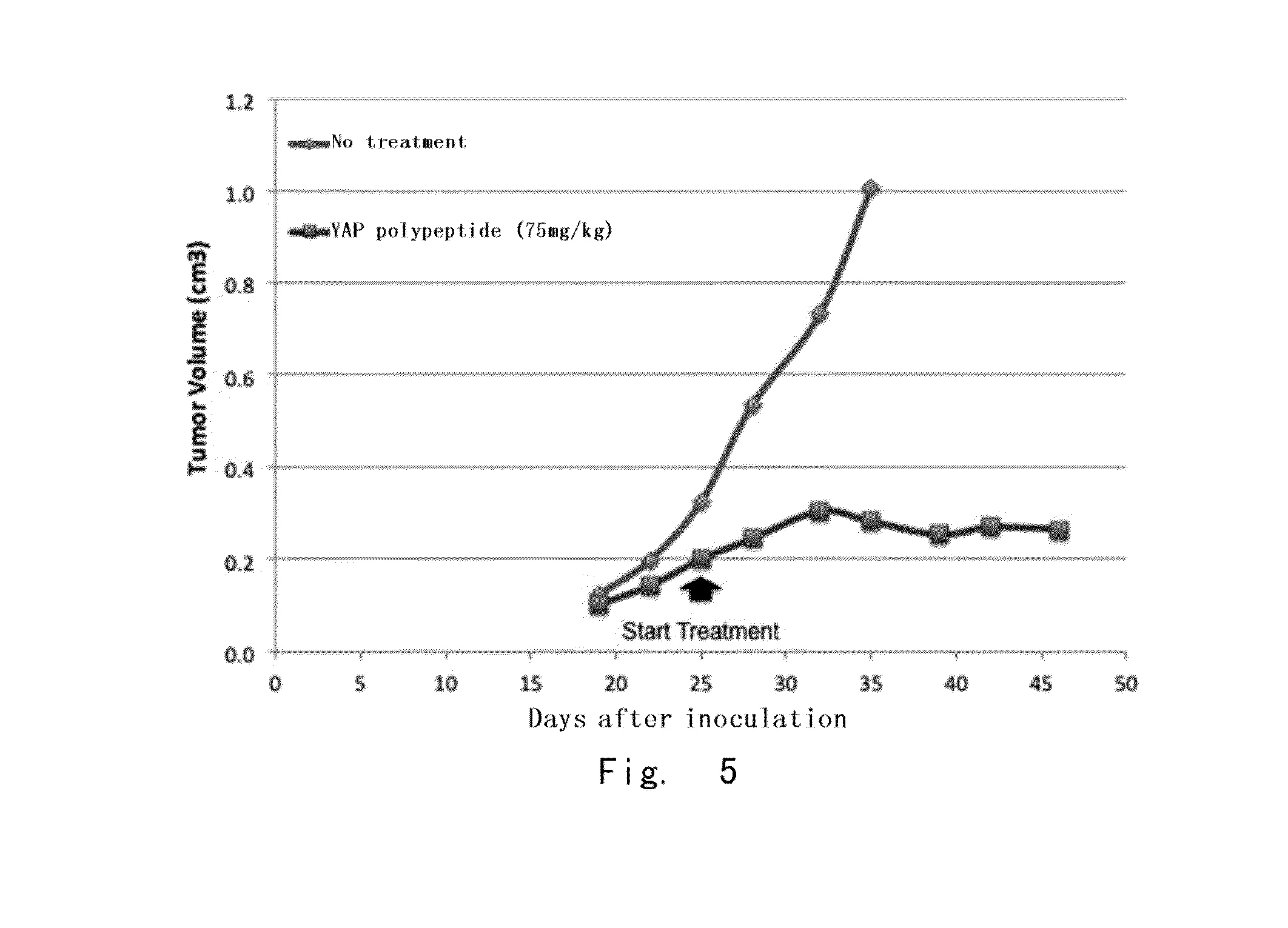Yap protein inhibiting polypeptide and application thereof
a technology of yap protein and polypeptide, which is applied in the field of tumor therapy, can solve the problems of unsatisfactory tumor treatment effect, high recurrence rate of liver cancer after surgery, and inability to use yap protein inhibitors, etc., and achieve the effect of inhibiting tumors and effectively inhibiting yap protein
- Summary
- Abstract
- Description
- Claims
- Application Information
AI Technical Summary
Benefits of technology
Problems solved by technology
Method used
Image
Examples
example 1
Screening of YAP Inhibitory Polypeptides
[0174]1.1 The inventor constructed different phage peptide libraries based on the arrangement of YAP protein. Candidate polypeptides inhibiting the binding of YAP-TEAD were selected after many screening tests. Then the inhibitory polypeptides which could efficiently penetrate cells, decrease activity of TEAD and down-regulate other YAP target genes were selected from the numerous candidate peptides. The screened YAP inhibiting polypeptides were confirmed via test-tube and PTDX animal model study. The YAP inhibiting polypeptides with successful therapeutic effect were finally obtained.
[0175]The results showed that YAP (AA50-171) embraced the orbicular structure of TEAD1 (AA194-411), and formed a broad interaction via three highly conserved protein interfaces. Interface 1 was the antiparallel β lamellar structure of YAPβ1 (AA53-58) and TEADβ7. Interface 2 was the mutual structure between YAP1α1 (AA61-73) helix and TEAD α3 and TEAD α4 helix. The ...
example 2
Modification of YAP Inhibitory Polypeptides
[0182]It was discovered that the polypeptide represented by SEQ ID NO.: 1 was difficult for effective uptake by cells and exhibited low stability, although the polypeptide could combine with TEAD in vitro.
[0183]In this example, the sequence was modified based on SEQ ID NO.: 1. Some preferred modification based on the tested results included: adding a disulfide linkage within the peptide, or adding a cell-penetrating element.
[0184]The test results were shown in table 2.
TABLE 2Percentageof CellpenetrationorSta-Sta-infiltrationbility*bility*PeptideStructure(%)(4 h)(>24 h)Peptide 100Peptide 2Peptide + Disulfide linkage89313Peptide 3Peptide + Cell-penetrating100493element 1 (RRMKWKK,SEQ ID NO.: 13)Peptide 4Peptide + Cell-penetrating135NDNDelement 2(RGRKKRRQRRR, SEQID NO.: 14)*The stability referred to the tested stability in plasma, and it was the percentage of residual peptides after a period of the testing time.
[0185]The results showed that th...
example 3
Modification of the YAP Inhibitory Polypeptides
[0186]Modification based on polypeptide SEQ ID NO.: 1:
[0187](a). The disulfide linkage was introduced in the peptide of SEQ ID NO.: 1, and the modified sequence was represented in SEQ ID NO.: 2.
[0188](b). X4 was replaced by Orn or Dab respectively based on the sequence of SEQ ID NO.: 2, and the modified sequence was represented by SEQ ID NOs.: 5 or 6.
[0189]For the YAP inhibitory polypeptides modified in above (a) and (b), the IC50 values for TEAD binding and the stability in plasma were measured. The test results were shown in table 3.
TABLE 3Stability*Stability*SEQ ID NO.:IC50(4 h)(>24 h)223 nM92%7%543 nM99%51%628 nM98%53%
[0190]The results showed that the plasma stability of the polypeptides after introducing a disulfide linkage was improved significantly and the stability were even more excellent with further modification of the polypeptides. Moreover, the IC50 values of all modified polypeptides were in nano molar order.
PUM
| Property | Measurement | Unit |
|---|---|---|
| Structure | aaaaa | aaaaa |
Abstract
Description
Claims
Application Information
 Login to View More
Login to View More - R&D
- Intellectual Property
- Life Sciences
- Materials
- Tech Scout
- Unparalleled Data Quality
- Higher Quality Content
- 60% Fewer Hallucinations
Browse by: Latest US Patents, China's latest patents, Technical Efficacy Thesaurus, Application Domain, Technology Topic, Popular Technical Reports.
© 2025 PatSnap. All rights reserved.Legal|Privacy policy|Modern Slavery Act Transparency Statement|Sitemap|About US| Contact US: help@patsnap.com



